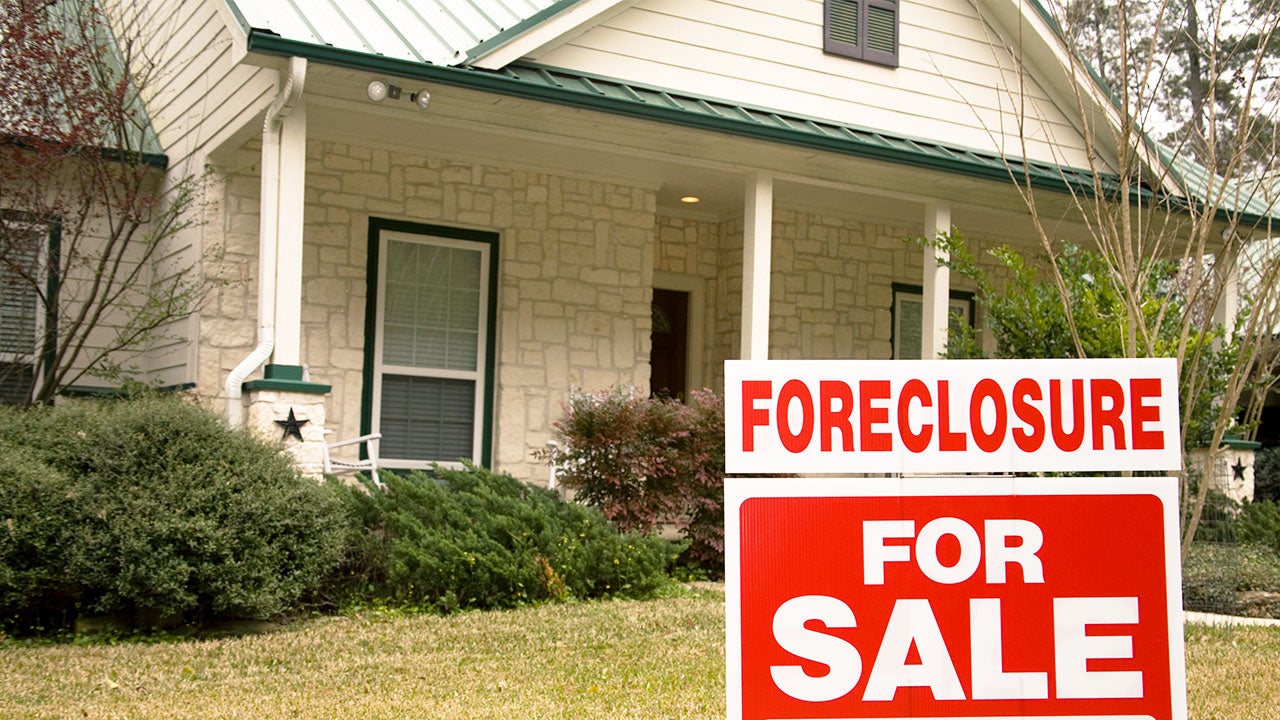What is a foreclosure? How it works and how to avoid it

Key takeaways
- A foreclosure occurs when a lender takes control over a property from a borrower for failing to make timely payments.
- A foreclosure can damage your credit score and result in loss of property.
- As soon as you realize you can’t pay your mortgage, reach out to your lender or servicer to learn about the mortgage relief options available to you — and ideally avoid foreclosure.
When you take out a mortgage, you agree to give your lender the right to foreclosure, meaning that they can take possession of your home if you don’t repay your loan. If you fall behind on several mortgage payments, your lender may begin the foreclosure process. This process can be lengthy, leading to months or years of financial and emotional stress. If unaddressed, foreclosure can lead to losing your home.
What is a foreclosure?
Foreclosure happens when the lender takes control of a property after the borrower misses multiple mortgage payments. This is also referred to as defaulting on the loan. In doing so, the borrower is breaking the mortgage contract they signed with their lender.
The borrower will receive a Notice of Default, which means the lender will start the foreclosure process. This process can take up to several years and ultimately result in the borrower being evicted.
Types of foreclosure
The types of foreclosures that can occur depend on your home state and mortgage terms. Some foreclosures involve legal action (judicial foreclosures), and others do not (non-judicial foreclosures). The types of foreclosures include:
- Judicial foreclosure: With a judicial foreclosure, the lender files a lawsuit and the borrower is notified of the non-payment. The homeowner has 30 days to make up the missed payments, otherwise the foreclosure process will proceed. Judicial foreclosure is a standard procedure nationwide, but certain states (listed below) only allow this approach and don’t permit other types of foreclosures.
- Power of sale: A power of sale foreclosure is allowed in some states if your mortgage has a power of sale clause in the contract. Once you fall behind on your payments, your mortgage provider is allowed to put the house up for auction. A power of sale foreclosure is considered a non-judicial foreclosure because no legal action is taken.
- Strict foreclosure: Strict foreclosures are less common because only a few states allow them. In this case, the mortgage lender files a lawsuit against the homeowner, and if the homeowner does not make up their payments within the court-ordered period, the lender can seize the home.
Judicial foreclosure states
The states that only allow judicial foreclosures include:
Non-judicial foreclosure states
States that allow both types of foreclosure—judicial and non-judicial—include:
Foreclosure process: How does foreclosure work?
Each state has its own laws pertaining to the foreclosure process and foreclosure sales. These laws can govern your mortgage relief options if you are already in foreclosure, how to post a Notice of Sale, the sale timeline and other parts of the process.
Step 1: Missed mortgage payments
If your mortgage payment is a few days late, you’re probably not at risk of foreclosure. Your lender may have a grace period of up to two weeks for you to make your payment without serious penalties. After the grace period, however, your payment is considered late and your lender will charge late fees. You might also receive a warning from your lender about a potential foreclosure if you fail to make the payment.
Step 2: Notice of Default
After three to six months of missed mortgage payments, your lender will file a Notice of Default with the local recorder’s office. Your lender will also send one to you via certified mail, and depending on your state, might post the notice on your front door. This notice specifies how much you owe to bring your mortgage back into good standing.
A Notice of Default could show up on your credit report and affect your score. This can make it more challenging to get other types of credit or refinance your mortgage.
Once you’ve received a Notice of Default, you need to act swiftly to avoid foreclosure proceedings. “Do not let this sit,” says Andy Manthei, a business development specialist with GreenPath, a non-profit that specializes in financial and housing counseling. “Don’t stick your head in the sand.”
At this point in the process, you have more options and should contact your lender to explore options like forbearance. You should also talk to a housing counselor. You can use the U.S. Department of Housing and Urban Development’s lookup tool to find a housing counselor in your state.
Step 3: Preforeclosure
Preforeclosure is the time between the Notice of Default and the auction or sale of your home. During this time, if you can pay the amount specified in the Notice of Default, you can stop the foreclosure process. The exact amount of time you have depends on your state.
During preforeclosure, you might also have the option to sell your home and pay back the money owed — a process called a short sale.
Step 4: Notice of Sale
If you don’t have the money to bring your mortgage into good standing within the allotted time frame, your lender will file a Notice of Sale. Then, your home will be placed up for auction at a specified time and place.
How the Notice of Sale is published depends on your state. For example, in North Carolina, the notice must be published in a local newspaper and posted on the door of the local courthouse. In California, it must be posted on the property, as well as a public place in the county.
Because the Notice of Sale is public information and has been advertised, several buyers, including investors, might be interested in buying your home. Depending on laws in your state, you might have the ability to exercise the right of redemption (meaning you can reclaim your home) up until the foreclosure sale, or even after.
Step 5: Eviction
Following the auction and sale of your home, you’ll generally have a few days to gather your belongings and move to a new residence. If you do not voluntarily move out, law enforcement personnel are legally allowed to remove you and your belongings from the premises.
What are the consequences of foreclosure?
Getting a mortgage after foreclosure can be challenging because of the impact on your credit score and the fact that you’ll likely need to endure a waiting period (usually, at least three years) before applying for a new loan. Other consequences of foreclosure include:
- Losing your home: You’ll need to find a new place to live with a foreclosure on your record. This won’t just have a financial impact but an emotional one, as well.
- Damage to your credit: A foreclosure stays on your credit report for seven years.
- Losing your property and equity: Not only will you lose your place to live, but you’ll also lose the money and effort you put into it. This can have far-reaching impacts on your overall wealth.
- Owing money: Depending on your state’s laws, you may owe money if your home sells at the foreclosure auction for less than you owe. The amount owed is called a “deficiency.” If you can’t pay, you may be sued, face wage garnishment and more.
How to avoid foreclosure
Ultimately, avoiding foreclosure starts by communicating with your mortgage lender or servicer. It is unlikely that your lender will let you off the hook completely, but it can help you take action so you don’t lose your home.
“Know you’re not alone,” says Manthei. Foreclosure can be a scary experience, but there are steps you can take to get help, he explains.
Some of the best ways to avoid a home foreclosure include:
- Contact a housing counselor: According to Manthei, a housing counselor will connect you with resources and prepare you for using them. “As certified counselors, we walk homeowners through every single option available based on their situation,” he says. You can contact a local HUD housing counselor or dial the HOPE hotline at (888) 995-HOPE to connect with a housing expert for 24/7 help.
- Take advantage of forbearance programs: You may be able to apply for forbearance, which temporarily postpones your obligation to make payments. If you go this route, make sure you develop a plan for when the forbearance period ends.
- Adjust your loan terms: If you are struggling to afford your monthly loan payment, ask your lender if they can modify your loan terms. In exchange for a longer amortization schedule, you might be able to lower your monthly payment.
- Get a deed-in-lieu of foreclosure: Some states allow homeowners to choose a deed-in-lieu of foreclosure, in which you agree to turn over your home to your lender to avoid foreclosure. With this option, you don’t need to pay your mortgage, but you might still be responsible for paying the difference between your home’s value and the mortgage balance.
- Set up a repayment plan: If you know that you are unable to make your mortgage payment for a given month, let your lender know as soon as possible. Your lender might set up a payment plan that involves more frequent but lower payments or deferral for a month or two.
Bottom line
Foreclosure is the process in which a mortgage lender takes control of your home because you didn’t make your payments. In short, it’s a situation you want to avoid. You can probably work out a more desirable solution by reaching out to your lender as soon as you know you might miss a payment.
FAQ
You may also like

How to refinance an underwater mortgage

What happens to HELOCs if home values fall?




